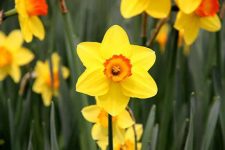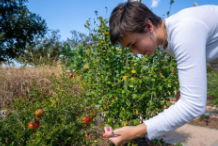Spireas are among the easiest flowering shrubs to grow. Once considered somewhat “common” or “old fashioned,” plant breeders have made vast improvements recently in growth habit, leaf and flower color, and overall garden appeal. Undoubtedly, all of the preceding were influential in prompting the National Gardener Bureau to name spirea as its “Shrub of the Year” for 2023.
The genus name, Spirea, originates from the Greek word, speira, or “wreath,” which makes reference to the orientation of the shrub’s delicate flowers. With nearly 100 species, this hardy genus of plants boasts a wide range of colorful foliage ranging from blue to yellow, red to orange, and nearly everything in between. Although native to Japan, China, and Korea, they have become American heartland landscape plants.
Common species and hybrids of this long-time garden favorite include:
- Japanese spirea (Spiraea japonica) is known for its wide flower and foliage color range, and its low-growing and mounding form.
- Bumalda spirea (Spiraea x bumalda) is similar to Japanese spirea but is a cross between S. albiflora and S. japonica. Flower color ranges from white to deep pink.
- Birchleaf spirea (Spiraea betulifolia) is known for its larger, blue-green, birch-like leaves and stunning fall color.
- Korean spirea (Spiraea fritschiana) is native to forests, slopes, and rocky areas and, like most spirea, attractive to butterflies. It is noted for its dark green foliage and large, white flower clusters that appear in late spring.
- Vanhoutte spirea, or bridal wreath, (Spiraea x vanhouttei) has been a landscape favorite for many years. It is known for its vase-shaped habit, flowing, arching branches, and cascading showy spring blooms. This inter-specific hybrid often is confused with Spirea prunifolia which has doubled flowers but fewer of them.
Although the preceding species and hybrids still are widely planted, new cultivars are available that add versatility to this useful shrub in home landscapes and gardens. The following represent a few notable examples:
- Tor Birchleaf – ‘Tor’ produces a compact mound of dark, gray-green, birch-like leaves that sport tiny white flowers in late spring. Like most birchleaf types, it boasts amazing fall color. Height: 3-4′. Width: 3-4′.
- Glow Girl® Birchleaf – A great plant for those who need easy, adaptable color for colder climates, it produces striking lemon-lime foliage. Height: 3-4′. Width: 3-4′.
- Rainbow Fizz™ – Aptly named, this new spirea adds a burst of color to the landscape with candy-like buds that emerge red and open to pink. Height: 3-4′. Width: 3-4′.
- Double Play Candy Corn® –The Double Play® series of spirea are continuous bloomers. ‘Candy Corn’ makes a great landscape statement with its brilliant foliage and red blooms that show all summer long. Other Double Play® cultivars include Big Bank, Artisan, Doozie, Gold, and Red. Height: 2-3′. Width: 2-3′.
- Pink Sparkler™ – This new birchleaf selection produces pink flowers in early summer and then again in autumn. The result is a late “pop” of color after most deciduous shrubs have stopped blooming. Height: 3-4′. Width: 3-4′.
- Superstar® – This new spirea offers three-season appeal thanks to its stunning, scarlet red new growth in spring, its pink blossoms from May to August, and its excellent bronze fall color. Height: 2-3′. Width: 3-4′.
- Firegold® – This new spirea bears brilliant lemon-lime foliage. Otherwise, it resembles the old-fashioned bridal wreath spirea, and arches gracefully while producing lovely white blooms in spring. Height: 4-6′. Spread: 5-7′.
- Little Spark® – This new, compact spirea produces orangish new growth that turns yellow. The yellow leaves are held throughout the summer, even in full sun. Height: 18-24″. Width: 18-30″.
- Renaissance bridal wreath – While more disease-resistant foliage than other bridal wreath cultivars, ‘Renaissance’ still produces classic white blooms that cover the plant. It is a selection from Spirea x vanhouttei. Height: 5-7′. Width: 6-8′.
- Goldflame – A selection from Spirea japonica, ‘Goldflame’ bears bronze-tinged new growth in spring. It produces dark pink flowers on plants with a compact, neat growth habit. Height 3-4′. Spread 4-5′.
- Dolchica – Unique in flower color for a spirea, ‘Dolchia’ produces graceful dark mounds of purplish flower clusters on purple-red foliage that matures in summer to green. ‘Dolchica’ is a selection from Spiraea x bumalda. Height 3′. Spread 4′.
- Little Princess – A petite selection from Spirea japonica, ‘Little Princess’ bears showy flat-topped clusters of bright pink flowers in early summer. Height 2′ Spread 3′.
-
- Snowmound – ‘Snowmound’ lives up to its name. It produces an abundance of snow-white flowers on graceful, spreading branches. Height 3-5′. Spread 3-5′.
- Even the most compact varieties of spirea establish themselves rapidly, making them ideal choices for quick fill-in plantings, massing, hedges, and foundations.Spireas are deciduous shrubs and drop their leaves each fall. Cold hardy from USDA Hardiness Zones 4–8, they can tolerate winter temperatures as low as negative 15 to negative 30 degrees Fahrenheit. Best grown in full sun, plants located in shadier spots tend to become lanky and do not bloom well. Although they prefer good, well-drained soil, spireas tolerate poor soil, pollution, drought, heat, the afore mentioned cold temperatures. Once established, they are one of the lowest maintenance, easy-to-grow shrubs available to gardeners. Normally, minimal supplemental watering is needed except during very dry weather. Mulching with wood chips or shredded bark will help retain moisture.
Routine pruning can be done to plants that are getting larger than desired. Since spireas bloom on “old wood” (previous year’s growth), it is best to prune after flowering. In addition to heading back, spireas should be thinned from the center to improve air circulation. Unlike some landscape plants, spireas can be pruned hard (reduced by two-thirds) to rejuvenate older, overgrown plants.
In general, spireas are not a preferred food source for wildlife such as deer and rabbits. However, their beautiful blooms attract an abundant show of butterflies, bees, and other pollinators.




